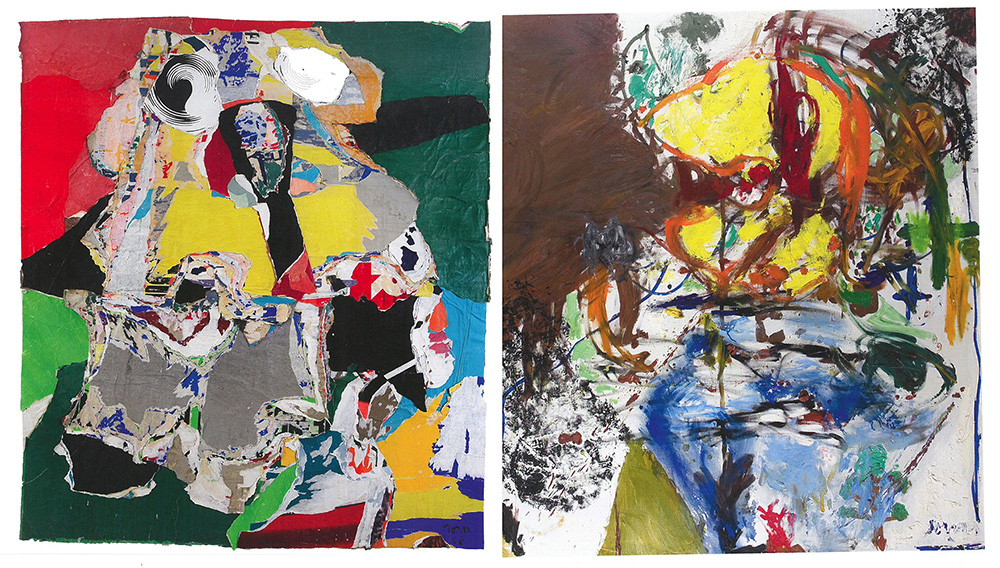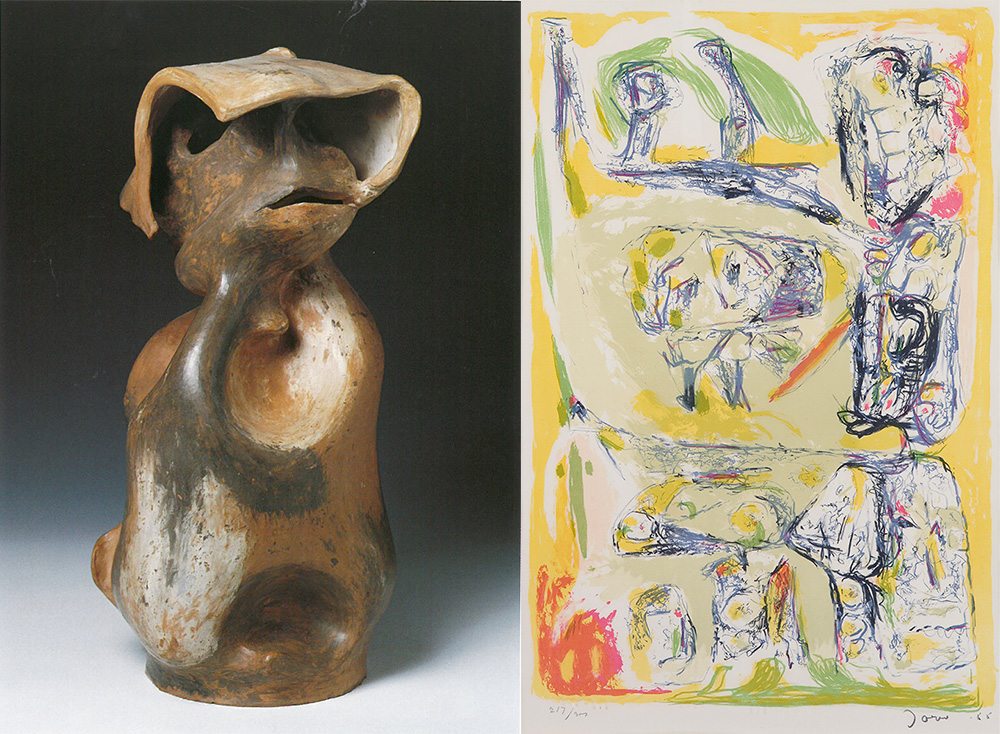ART CITIES:Hamburg-Asger Jorn
 For Asger Jorn, who was aligned with the CoBrA Movement and later the Situationist International, art was an expression of life, of activism, of an unedited freedom not confined to studio practice. Over a diverse and multifaceted career spanning 50 years, Jorn’s work attests not only to this belief, but also to a practice permeated with excesses.
For Asger Jorn, who was aligned with the CoBrA Movement and later the Situationist International, art was an expression of life, of activism, of an unedited freedom not confined to studio practice. Over a diverse and multifaceted career spanning 50 years, Jorn’s work attests not only to this belief, but also to a practice permeated with excesses.
By Dimitris Lempesis
Photo: Deichtorhallen Hamburg Archive
The exhibition “Without Boundaries” present the work of Asger Jorn , one ofthe most important Danish artists of the 20th Century. The concentrated selection of the 60 works that are on presentation ranges from Jorn’s early work, which was influenced by artists such as Paul Klee, Joan Miró, and Max Ernst, to his ceramic works and his late expressive, gestural paintings. With his extraordinarily powerful style between abstraction and figuration, Asger Jorn created dynamic pictures that range from playful lightness to the depths of the soul. Tirelessly painting and writing, Jorn combined Scandinavian culture with the international Avant-Garde in his works, building bridges between free, experimental design and formal clarity. Throughout his life, Jorn was in contact with leading thinkers and artists. He worked with Fernand Léger on large-scale decorations for Le Corbusier’s Pavillon des Temps Nouveaux and was a founding member of the CoBrA group and the Situationist International, a group of artists who positioned themselves against capitalist functionalism. Asger Oluf Jørgensen was born on 3/3/1914 in Vejrum in the western part of Jutland. Jorn attended teacher training college here, joined the boy scouts, and his association with the syndicalist Christian Christensen sharpened his political commitment. On and off during his life, Jorn was a member of the Communist Party, but developing a very personal and independent political stance. He was taught by the painter Martin Kaalund Jørgensen and had his first show at the exhibition by Frie Jyske Malere (Free Jutlandic Painters) in 1933. In 1936 he drove his motorbike to Paris where he applied to study at Fernand Léger’s school of painting. Here he met the French artist Pierre Wemaëre. Jorn worked for Le Corbusier at the World Exhibition in 1937. The following years, he returned to Paris, but spent the winter season at the Royal Academy of Fine Arts in Copenhagen. In 1938 Jorn travelled briefly to Norway in the company of Pierre Wemaëre before continuing at the Royal Danish Academy of Fine Arts. During the German Occupation, Jorn published the journal “Helhesten” in conjunction with Egill Jacobsen, Ejler Bille, Carl-Henning Pedersen, and the architect Robert Dahlmann Olsen. This was a comprehensive journal and the articles covered everything from African masks and Nordic folk art to jazz, Surrealism, and children’s drawings. All of it intended to provoke the German occupational power. Concurrently with this, the artists evolved a spontaneous-abstract idiom. On 25/81945, Asger Oluf Jørgensen changed his name to Asger Jorn, which went down better abroad. The same year Jorn entered Norway illegally to see the big retrospective Munch exhibition at the National Gallery. In the autumn of 1948, Jorn established CoBrA (Copenhague, Brussels and Amsterdam) together with the Belgian poet Christian Dotremont and the Dutchmen Karel Appel, Constant, and Corneille. The group also included the spontaneous-abstract Danish artists from the artists’ group Helhesten. During a conference at Bregnerød in 1949, the artists painted the walls and ceiling in the weekend cabin frequented by architect students. The Dutch artists stayed away in protest, since Jorn and Constant’s wife Matie van Domselaer had started a relationship. They married in 1950 and had two children. Later, some of the Cobra artists also painted the potter Erik Nyholm’s house in Funder. Cobra was dissolved in 1951. Jorn was living in the Danish House in Paris with his family. Sick and exhausted from tuberculosis, he returned in 1952 to Silkeborg where he was admitted to the local sanatorium. Soon after, he began to paint, e.g. the two monumental paintings “Af den stumme myte” for Silkeborg Municipal Library. Jorn worked in clay with the potter Knud Jensen in Sorring. 22 works from here constituted the beginnings of the huge donation of 5,500 works of art which he donated to the town of Silkeborg over the next 20 years. In 1953, he executed 21 light drawings on the request of the photographer Poul Pedersen. After a few months in Switzerland, he went to the Italian coastal town of Albissola near Genoa. Shortly after his arrival, he set up an international festival of fire and clay. From then on, Jorn spent the summer months in Albissola and the winters in Paris. In 1957, Jorn established the experimental and revolutionary artistic movement Situationistisk Internationale (SI) in conjunction with: Pinot Gallizio, Guy Debord, Michèle Bernstein, and Ralph Rumney. Jorn published the book “Pour la forme” (1957), in it outlining his artistic and theoretical considerations. Jorn and Debord created the artists’ books “Fin de Copenhague” (1957) and “Mémoires” (1959). In 1958 Jorn’s painting “Lettre à mon fils”, was displayed at the World’s Fair in Brussels. This was Jorn’s international breakthrough. In Albissola, in the summer of 1959, he worked on a relief measuring 27 m x 3 m for the sixth-form college Aarhus Statsgymnasium. Concurrently with this, the execution of a 14 m tapestry “Den lange rejse” was begun in Paris supervised by Pierre Wemaëre and himself – for the same college. Jorn resumed his old plan of a grand presentation of ancient Nordic art in book form. This resulted in an archive containing more than 25,000 photos by the French photographer Gérard Franceschi. Jorn had the idea that these archives would evolve into a study centre of ancient Nordic art: Scandinavian Institute for Comparative Vandalism (SISV). Jorn published “Value and Economy” in 1962. In 1964, the world-renowned Danish architect Jørn Utzon presented his first proposal for a museum to house Jorn’s collection in Silkeborg. Jorn had himself wanted Utzon to design the building, but neither of the two final projects were ever realised. In 1964, Jorn took part in a number of international art exhibitions and his first retrospective exhibition took place in Basel, Amsterdam, and at Louisiana near Copenhagen. Jorn refused the Guggenheim award. In 1965, he had to abandon the SISV project, but published several books on selected topics later. During the New Year 1966-67, he executed a number of large lithographs in Switzerland. In September of that year Jorn took part in a travelling exhibition in Oslo, Bergen, Trondheim and Gothenborg. He went on to travel round Norway and Sweden in order to seek out potential contributors to the book series about 10,000 years of Nordic folk art. A list of authors for a total of 28 volumes was settled upon. In 1969 Jorn went to Oslo where he researched the legend of the Gothic King Didrik in both pictures and words. Jorn was particularly interested in the relationship between myth as narrative and image as myth. It was on this occasion that he presented his hypothesis of image being prior to myth. In Albissola, Jorn spent the summer 1972 working on a series of clay sculptures that were later cast in bronze. He went to Denmark where he was planning a two-volume work on Theoderik, king of the Goths, and Didrik, his opposite number in the Nordic sagas. In January 1973, he was admitted to Aarhus District General Hospital. In early April, he went to Albissola confirming that he would hand over his property to the town while ensuring that his friend Umberto Gambetta and his wife could stay in the house for the rest of their lives. Jorn died in Aarhus on 1/5/1973 and buried on Grötlingbo Cemetery in Gotland.
Info: Deichtorhallen Hamburg, Hall for Contemporary Art, Deichtorstraße 1-2, Hamburg, Duration: 22/6-23/9/18, Days & Hours: The-Sun 11:00-18:00, https://deichtorhallen.de




